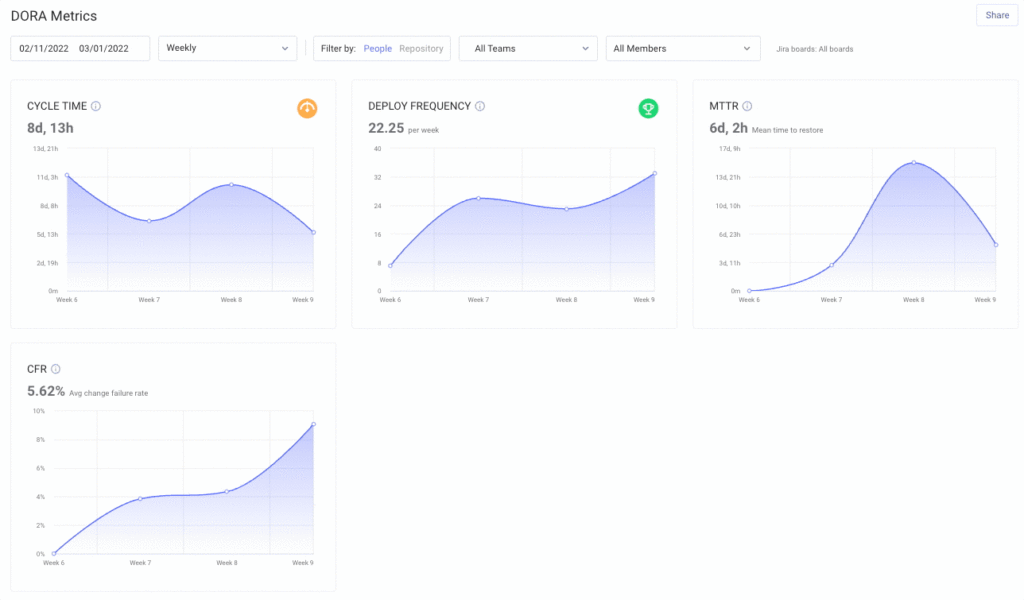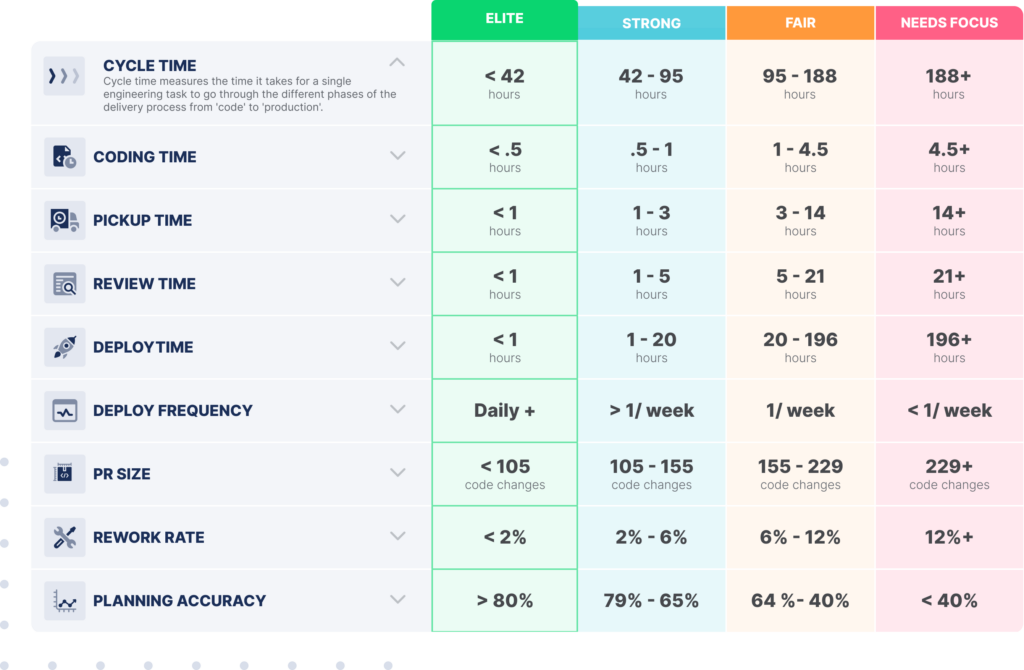Optimizing software delivery is critical to your org’s success. But without visibility into the key performance indicators (KPIs) of software delivery, it can be difficult to make informed decisions on optimizing that process. It’ll also be challenging to communicate your teams’ progress and successes to other stakeholders without the right data.
That’s where a DORA metrics dashboard comes in. This dashboard ensures you can identify bottlenecks, improve collaboration between teams, optimize delivery speed, and effectively communicate your teams’ successes.
In this article, we’ll show you how to save yourself the hassle of building a DORA metrics dashboard manually.
Table of Contents
- What Are DORA Metrics?
- Challenges in Building a DORA Metrics Dashboard
- How to Build a DORA Metrics Dashboard with LinearB
- Metrics Alone Don’t Improve Dev Teams
What Are DORA Metrics?
DORA metrics — developed by the DevOps Research and Assessment (DORA) team — measure your software development teams’ velocity and stability.
These four key metrics can make or break your org’s productivity:
- Deployment frequency measures the number of times code is deployed into production.
- Lead time for changes (aka cycle time) measures the average time it takes for code to go from first commit to being released to production.
- Mean time to recovery (MTTR) calculates the average time it takes for a team to recover from a failure or incident.
- Change failure rate measures the percentage of failed deployments or deployments that result in incidents.
Check out this video with Dana Lawson (VP of Engineering at GitHub), Charity Majors (CTO at Honeycomb), and Kathryn Koehler (Director of Productivity Engineering at Netflix) as they discuss how they apply DORA metrics to facilitate continuous improvement in their businesses:
Challenges in Building a DORA Metrics Dashboard
Building a DORA metrics dashboard can be challenging. In particular, we’ve highlighted two areas that are time-consuming and error-prone when done manually.
1. Correlating Data from Different Sources
Trying to get all your data together from different places is one of the biggest challenges when building a DORA metrics dashboard. For example, to measure the lead time for changes, you need to collect data from code commits made in git and compare it with the deployment dates recorded in Jenkins.
Similarly, to measure change failure rates, you need to correlate data from project management tools like Jira or Shortcut with your CI/CD pipeline. This may involve manually exporting and importing data which can take up a lot of your time. You might also face data formatting issues across different tools, which could result in errors when comparing and correlating that data.
2. Effectively Visualizing Performance
Another challenge is choosing the right visualization techniques that effectively communicate your teams’ performance. DORA metrics generate a lot of complex data, and trying to effectively see everything can be a mammoth task to handle manually.
Your DORA metrics dashboard should be user-friendly and provide a clear overview of each team’s software delivery performance. And it should do this without overwhelming users with too much data. The dashboard should also be easily customizable to suit different people’s needs, such as developers, managers, or executives.
So you’ll have to figure out how to give your dashboard all these features, either by doing it from scratch or by outsourcing some tools. But that’s not very time-efficient.
Fortunately, you can work around this manual process with a DORA metrics tool that can automate data collection and correlation from various sources and offer customizable visualization options.
How to Build a DORA Metrics Dashboard with LinearB
If you’re looking to build a DORA metrics dashboard, LinearB is the best tool for the job. It pulls in data from all your sources and presents it in a way that you — and everyone else in your org — can understand. That way, you’ll have real-time visibility into your teams’ KPIs to spot bottlenecks and make informed business decisions.
It only takes three steps to get (and maintain) your DORA metrics dashboard!
Step 1: Connect Your Data Sources
Set up your LinearB account by connecting to your Git provider, project management tool, and incident and release detection software.
Once your data sources are connected, you’ll automatically have access to a DORA metrics dashboard that comes out of the box. To find it, just go to the Metrics tab and select “DORA Metrics” from the left menu of available dashboards.
Step 2: Filter Your Key Metrics
Once you’ve navigated to your DORA metrics dashboard, you can filter the DORA metrics according to what kind of data you want to see. Your dashboard can be filtered to show data for specific date ranges, one or multiple teams, or even specific repos.
This will enable you to zero in on the data that matters the most for your teams and other stakeholders.

Step 3: Automate Team Configuration
Finally, you can automate your teams’ configuration with the Automated Team Configuration feature. This will sync your GitHub teams with LinearB, so you don’t have to do manual updates in LinearB when team members change in GitHub down the line.
Your DORA metrics will always be accurate because you’ll always be working with the most up-to-date team configurations.
Metrics Alone Don’t Improve Dev Teams
While DORA metrics are a critical component of measuring your org’s productivity and efficiency, metrics alone can’t improve your dev teams. It’s essential to also have a tool that helps you do something with the insights from your DORA metrics dashboard.
LinearB’s Engineering Benchmarks compares your metrics against industry standards to identify where you need to improve.

You can then use Team Goals to set objectives for your teams’ DORA metrics and track progress toward those goals. And our AI-powered bot, WorkerB, lets your teams know when they’ve missed a goal or are about to. By focusing your goals and alerts on leading indicators like PR size and pickup time, you’ll see a significant improvement in your cycle time and deployment frequency.
Finally, use gitStream, our workflow automation tool, to implement policies around your PR review process to reduce failures and improve CFR. For example, gitStream’s code experts ruleset routes PRs to the most qualified contributors based on blame and activity filters to ensure changes get sent to the best reviewers.
By combining DORA metrics with programmable workflows, LinearB provides a comprehensive solution for optimizing your teams’ performance. With the ability to identify bottlenecks quickly, track progress towards goals, and automate improvement, you can easily go beyond visibility into a DORA metrics dashboard and have a plan to improve your teams.




